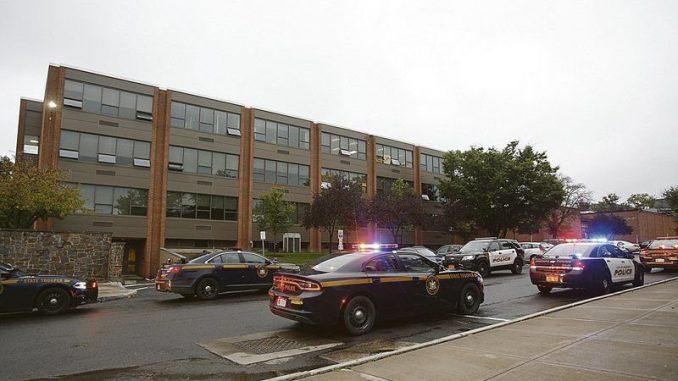
Casey McShea, Arts Editor
My class ran late last Wednesday.
I walked up to Hunt Union after, where my three co-editors for the paper already were. I sat and started joking around as we edited for our latest issue. The only abnormal thing about any of it was that it had been raining outside and my hair was a little wet.
My phone started ringing before I could fully read the email notification that had already popped up on my lock screen. I saw the email had been from Oneonta, and figured that if I were getting a call, too, it was the emergency alert system. I made a joke about another tornado hitting, like last year, because the weather had been so gloomy all day, and answered the phone. I put it on speaker.
We heard “threatening to shoot,” and the world stopped.
My mind went blank for a moment. My heart felt like it had stopped beating. The room was painfully quiet as we tried to process what we had just heard.
Instinct took over. I ran and slammed the door shut. We shut the lights off. Everyone pulled out their phones and started texting. My phone was already blowing up from group chats and my mom. I’ve never asked so many people so many times, “Where are you?” and needed the answer like a lifeline.
For 45 minutes, four of us sat in the dark with only the glows from our phones lighting our faces.
The printer made a weird noise, at some point. We unplugged every wire we could find. We started looking around the room to see what we could use in case we needed to defend ourselves. I tested picking up a computer. Someone else held scissors in his hand.
When the all-clear was given, we didn’t feel safe. No one was hurt, but we still didn’t feel safe. It’s two days later and campus still doesn’t feel safe. I walked through an almost-deserted Fitzelle the day after and all I could think was, “Where would I go right now if I had to run?”
There are some who will say that no one should be upset about the incident on Wednesday, that there was no real threat, that no one got hurt. To an extent, I understand this. Yes, no one got hurt. Yes, it could have been so much worse.
That does not change the fact, however, that many students are traumatized by the experience and SUNY Oneonta seemed ill-prepared to react to the situation at hand. There needs to be serious change in the way our campus and faculty responds to situations like these.
Students were reportedly more proactive than some faculty members. Some friends have told me that their professors ignored the message and kept teaching. Others said a professor told his students to run.
The University’s President, Barbara Morris, even acknowledged that the college had not been properly prepared, stating in an email sent out last Friday, “The college was not ready to respond effectively, and must do better. We are working hard toward that and to assist students affected by Wednesday’s incident.”
There is no way to emotionally prepare for a situation like this, but there are ways to prepare how to act. Faculty members should be mandated to attend active shooter trainings. Students should be offered the opportunity to attend these trainings as well. They should (at the least) include standard lockdown and shelter-in procedures.
In today’s day and age, when mass shootings are all too common occurrences, it is not acceptable for schools to not prepare for shooter situations. Outside of school preparedness, gun control laws in this country need to change. While, thankfully, no one was hurt in Oneonta, how many other lives have been lost to mass shootings? How many more people need to be shot before laws are changed? Though it is a good thing that SUNY Oneonta’s administration is taking steps towards improving the campus’ crisis response, it should not have had to in the first place. A lack of restrictive gun laws in this country have forced students in schools and universities into a mentality where they are sadly, prepared to act accordingly in a situation like the one last Wednesday.
We don’t forget Columbine. Sandy Hook. Las Vegas. Parkland. Sutherland. Orlando. El Paso. We won’t forget what we’ve learned at SUNY Oneonta, either.
Leave a Reply